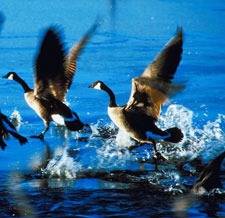Canada Goose Information
Goose Dispersal Techniques
Habitat Modification
In many instances, geese tend to walk to and from water to feed instead of flying. If overgrazing or fecal accumulation is occurring on lawns or gardens adjacent to a pond or lake, installing a low fence or other barrier may prevent geese from accessing the problem area. This type of barrier may consist of a single strand of 16 gauge galvanized wire, rot-resistant twine, heavy monofilament fishing line, chicken wire, closely planted shrubs or even a rock wall. The single strand of wire or twine should be about 8 inches high while other barriers should be at least 2 feet high. Electric fencing can also be very effective. Barriers should be placed directly adjacent to the water's edge. If you own the pond, you may consider allowing vegetation to “grow-up” around the edge. Geese prefer ponds that are "open" and have low growing vegetation around the sides.
Curtailing the mowing of vegetation may diminish the attractiveness of the pond by not affording the geese security of an "open" pond and also by not encouraging new plant growth to which geese are attracted. Taking down goose nesting platforms or modifying existing small islands or peninsulas in ponds will also make areas less attractive for nesting geese.
Overhead Lines
Overhead lines crisscrossed over a small pond have been successfully used as a long term solution in keeping geese away from water and surrounding areas. These lines interfere with geese attempting to land and take off from the water, and the geese frequently abandon such areas in a relatively short time. The lines should crisscross the pond about 3-6 feet above the water and be spaced approximately 20 feet apart. If this spacing proves ineffective, a 10 foot grid may be necessary. Attaching mylar tape on the lines increases effectiveness. Contact the US Department of Agriculture - Wildlife Services (803-786-9455) for detailed information.
 Noise-making Devices
Noise-making Devices
In some areas, noise-making devices are the most recommended and most successful harassment method. There are a variety of noise-making devices available including pyrotechnics, automatically firing propane cannons and exploding shells for 12 gauge shotguns. The various noise-making devices are most effective when they are fired so they will go off under the birds just as they are about to land. Propane cannons provide an extremely loud noise and are most appropriate in rural areas and large agricultural fields where the noise is not likely to bother neighbors. The Bureau of Alcohol, Tobacco, Firearms, and Explosives (ATF) requires a Federal Explosives Permit for the use of certain types of pyrotechnics so consult authorities before using these. When using any of these devices, please inform local police, wildlife enforcement officers and neighbors as to your actions. Also check local ordinances to see if these devices can be used in your area and/or if any special permits are needed. Some of these devices can be dangerous when used improperly. Follow instructions and use eye and ear protection when using scare pistols and cannons.
Hunting
When damage is occurring outside of city limits or other "sanctuaries", legal hunting is a very successful means of alleviating goose damage. In rural areas where geese are a problem, adjacent landowners may consider combining efforts to allow hunting on a series of farms, lakes or ponds. Because seasons last only a few weeks, hunting in itself is usually not enough to disperse birds for a long period of time; however, successive years of high hunting pressure may limit or reduce populations thereby making future goose damage more tolerable. Hunting resident geese is allowed throughout South Carolina during several Canada goose seasons; however check regulations each year to determine exact season dates, bag limits and other regulations for your location. A Federal migratory bird stamp, appropriate state stamps and licenses and non-toxic shot are required to hunt Canada geese.
Chemical Repellents
Various goose repellents currently on the market have proven ineffective; however repellants made from grape skin extracts show promise in repelling geese. Cost and labor are limiting factors when using repellents due to the high cost of the chemical and the repeated applications necessary after rains or mowing. Contact USDA – Wildlife Services for more current information.
Egg Destruction
The US Fish and Wildlife Service (USFWS) has adopted new rules for managing resident Canada geese including a nest and egg depredation order for resident Canada geese that authorizes private landowners, public land managers, homeowners’ associations and local governments to destroy resident Canada goose nests and eggs on property under their jurisdiction when necessary to resolve or prevent injury to people, property, agricultural crops or other interests. The order does not authorize the killing of any migratory bird species or destruction of any nest or eggs other than those of resident Canada geese.
During the period March 1 to June 30, egg destruction by oiling, shaking (addling) or puncturing may be used. Egg addling or oiling should take place after the female has laid all her eggs. When addling eggs, visit all known goose nests and shake eggs vigorously, thereby making embryos unviable. Return eggs to nest, taking care not to destroy the eggs. Geese should return and continue incubating for addling or oiling to be effective. Geese will eventually abandon nests, but probably will not re-nest that year. Spraying eggs with corn oil will block oxygen transfer and will provide the same effect as egg shaking (Only corn oil can be used because other types of oil are not registered for this use). Keep neighbors apprised of your plans or at least consider how they may feel about this technique. Relocation of nests or eggs is not permitted.
Landowners are required to self-register with the USFWS via the Internet at https://epermits.fws.gov/eRCGR/geSI.aspx. No permit is required from the South Carolina Department of Natural Resources . A how to video about egg oiling is available at https://www.youtube.com/watch?v=2CLIL-381Lw
